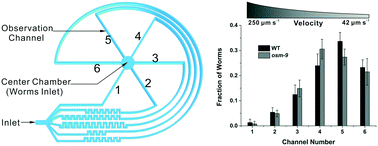Profile analysis of C. elegans rheotaxis behavior using a microfluidic device†
Abstract
The directed motility of organisms in response to fluid velocity, which is called rheotaxis, is important in the life cycle of C. elegans, enabling them to navigate their environment and maintain their positions in the presence of adverse flow. Thus, to study the mechanism underlying rheotaxis behavior and reveal information on parasitic diseases, the profile analysis of the rheotaxis response in worm populations with high resolution in well-defined fluid environments is highly desirable. In this work, we presented a rapid and robust microfluidic approach to quantitatively analyze the rheotaxis behavior of worms in response to velocity. The flow-based microfluidic chip contained six helical spline microchannels for generating six flow streams with different flow velocities. Since the worms loaded in the chip would swim upstream into channels, the distribution of the worms in response to the different flow velocities was successfully monitored for the quantitative analysis of their rheotaxis behavior using this microfluidic chip. The results indicated that the rate range of around 50 μm s−1 was the most favorable flow velocity for the wild-type worms. Further, we analyzed ASH neuron-blocked worms and found that the functionally defective ASH neurons inhibited their sensitivity to flow rate. In addition, the rheotaxis analysis of the mutant worms indicated that TRP mechanosensory channels and serotonin signals also play a regulatory role in the rheotaxis response of these worms. Thus, our microfluidic method provides a useful platform to study the rheotaxis behaviors in C. elegans and can be further applied for anti-parasitic drug tests.



 Please wait while we load your content...
Please wait while we load your content...